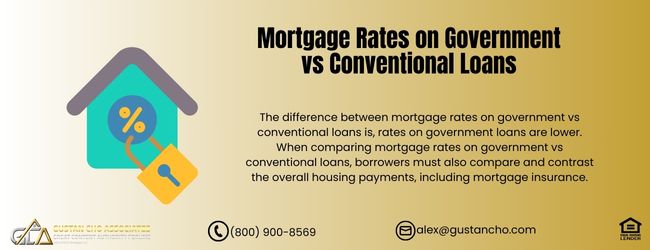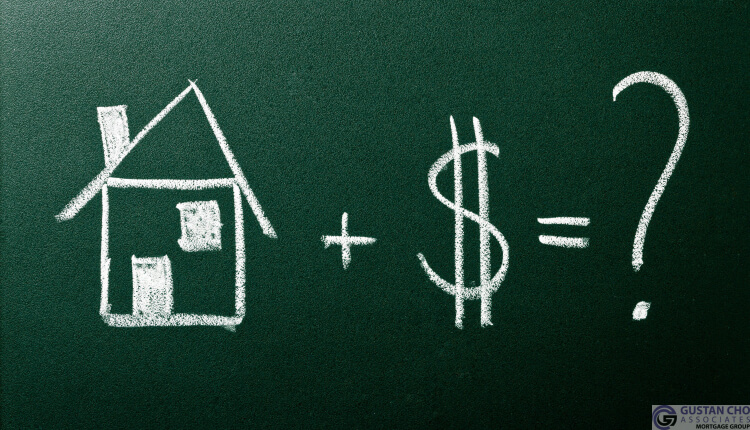Mortgage Rates on Government vs Conventional Loans

This blog will compare mortgage rates on government vs conventional loans on home purchase and refinance transactions. Are mortgage rates on government vs conventional loans on purchases and refinance lower? This is one of the most frequently asked questions at GCA FORUMS Mortgage Group. Getting the best mortgage rates is important. Getting the lowest mortgage rates mean tens of thousands of dollars in savings during the term of the loan. Chad Burns, a dually licensed loan officer and real estate agent of GCA FORUMS Mortgage Group explains the differences of mortgage rates on government vs conventional loans as follows:
Lower rates mean tens of thousands of savings over the home loan term. This is why borrowers should always compare and contrast not just mortgage lenders but loan programs as well.
There are three different types of government-backed loan programs: FHA, VA, and USDA loans. Conventional loans are not guaranteed by the government. Conventional loans are private loans. In general, government-backed loans have lower mortgage rates due to the government guarantee. However, government loans come with mandatory mortgage insurance premium. Private mortgage insurance is required on conventional loans for borrowers with higher than 80% loan-to-value. Over 35% of all home loans in the United States are FHA loans. FHA loans are very popular due to the government guarantee by HUD. HUD is the parent of FHA. FHA is not a lender.
Mortgage Rates on Government vs Conventional Loans: What is The Role of HUD and FHA?
HUD does not originate nor fund FHA loans. HUD, the parent of FHA, is a government agency that insures and partially insures banks and lenders whose FHA loans are in default or foreclosed. FHA will cover all or a partial loss the bank or lenders have taken a hit. For FHA loans to be insured, lenders must follow all of the minimum HUD Agency Mortgage Guidelines. Lauren Wright of The Wright Realtor, a Chicago-based real estate agent explains about mortgage rates on government vs conventional loans as follows:
Banks and private lenders are the financial institutions that originate, process, underwrite, and fund FHA loans. The role and function of HUD is to insure and partially guarantee lenders on FHA loans that defaulted and foreclosed.
HUD will insure and partially guarantee the lender’s loss. Due to this government guarantee, lenders can offer FHA loans with a 3.5% down payment with less-than-perfect credit at low mortgage rates. There are instances where homebuyers will get lower mortgage rates on government vs conventional loans. In other instances, a conventional loan will be a better fit for a mortgage borrower with good credit and higher credit scores. We will look at the best loan program in this article for a borrower. Speak With Our Loan Officer For Your FHA Loans
Comparing Mortgage Rates on Government vs Conventional Loans
Many homebuyers automatically assume government loans have higher mortgage rates due to the lenient agency mortgage guidelines versus conventional loans. This is not the case. It is the exact opposite. Due to the government guarantee, mortgage rates on government loans are between 0.25% to 1.00% lower than conventional loans for borrowers with similar credit scores.
How Credit Scores Impact Mortgage Rates on Government vs Conventional Loans
The higher the borrower’s credit scores, the lower the mortgage rates. Borrowers with lower credit scores will get lower mortgage rates on government vs conventional loans. Conventional loans are not insured nor partially guaranteed by any government agency. Therefore, mortgage rates on conventional loans are substantially higher for lower credit score borrowers. For example, the minimum credit score to qualify for conventional loans is 620 FICO. Mortgage rates on conventional loans for a borrower with a 620 credit score may be very high, plus lenders will require discount points. On FHA, VA, or USDA loans mortgage rates may still be reasonable for borrowers with credit scores in the 500s with no discount points. Often, it is best to go with government-backed loans for borrowers with lower credit scores.
How Do Lenders Price Mortgage Rates on Government vs Conventional Loans?
Higher risks mean higher rewards. This holds true with lenders. The biggest factor in pricing mortgage rates are credit scores. There are other loan-level pricing adjustments (LLPAs) that factor in the pricing of mortgage rates, but credit scores is the biggest factor in pricing rates. Borrowers with layered risk factors will be charged a loan-level pricing adjustment, often called LLPAs. LLPAs are pricing adjustments to the mortgage rate on negative factors that induce risk for lenders.
Factors That Affect Pricing on Mortgage Rates on Government vs Conventional Loans
Here are the main factors that affect mortgage rates on FHA loans:
- Borrower’s Credit Score
- Minimum And Maximum Loan Amounts
- There are pricing hits on under $200,000 loan balances and pricing adjustments on high-balance FHA and Conforming loans in high-cost areas
- Loan Type (Single-Family Home Purchase, Streamline Refinance, 203k Rehab, Manufactured Homes, FHA high-balance, 2 to 4 unit multi-family, condominiums, townhomes, second home, investment properties, New Construction)
- Detached Single-Family Homes are considered the safest investments for lenders with no pricing adjustments.
- Manual Versus Automated Underwriting System
- Debt-to-Income Ratios
- Property Location: There are pricing adjustments to mortgage rates in declining housing market areas and other areas due to geographic factors which induce risk to the lender
- There are no loan-level pricing adjustments on prior bad credit including bankruptcy, foreclosure, deed-in-lieu of foreclosure, or short sale.
Pricing Adjustments on Mortgage Rates on Government vs Conventional Loans
There are no pricing adjustments for borrowers with prior bad credit such as bankruptcy, foreclosure, deed-in-lieu of foreclosure, short sale, late payments, outstanding collections, and charged-off accounts. Pricing mortgage rates on conventional loans are similar to FHA, VA, and USDA loans. All the above factors will impact mortgage rates on conventional loans. Since conventional loans are not insured or partially guaranteed by a government agency, loan-to-value plays into pricing mortgage rates. The lower the loan-to-value, the more safety lenders have. Therefore, a lower loan-to-value means better mortgage rates and lower loan-level pricing adjustments on conventional loans. Conventional loans normally benefit borrowers with higher credit scores and larger down payments. Click Here To Get Qualify For Conventional Loans
Lower Rates Versus Higher Housing Payments Due To Mortgage Insurance
All 30-year fixed-rate FHA loans have mandatory FHA mortgage insurance premiums. A one-time 1.75% upfront FHA MIP can be rolled into the balance of the FHA loan. The second mortgage insurance premium is the annual 0.55% FHA Annual MIP charged for the life of the 30-year fixed-rate FHA loan. With conventional loans, private mortgage insurance is not required for borrowers with 20% or more equity in their home purchase.
Mortgage Insurance on Conventional Loans
Difference between mortgage rates on government vs conventional loans is, rates on government loans are lower. However, on FHA loans you have a lifetime FHA annual MIP on 30-year fixed-rate FHA loans. For any loan to value higher than 80% LTV, private mortgage insurance is required on conventional loans. However, the rate of private mortgage insurance is not fixed like FHA. PMI premiums vary depending on the borrower’s credit scores and the loan to value. Borrowers with lower credit scores and higher loan-to-value may get higher premiums on private mortgage insurance. When comparing mortgage rates on government vs conventional loans, borrowers must also compare and contrast the overall housing payments, including mortgage insurance.
FAQs on Mortgage Rates on Government vs Conventional Loans
Here is an FAQ on Mortgage Rates on Government vs. Conventional Loans
Differentiating Government vs Conventional Loans
- Government Loans: These loans are federally insured or federally backed, including FHA, VA, and USDA loan programs. They are meant for certain target groups, such as new home buyers, veterans, and low—to medium-income borrowers.
- Conventional Loans: These loans are not government-backed and are offered to private lenders. They may either conform to the loan limits of Fannie Mae and Freddie Mac or be nonconforming loans, such as jumbo loans.
Are the Rates on Government Loans Lower Than Those on Conventional Loans?
Government loans (FHA, VA, USDA) have lower interest rates than conventional ones. This is supported by the fact that they are guaranteed by the government in case of a default, reducing the lender’s risk level. Sometimes, conventional loans may have higher rates than usually expected. This is especially true for those with lower credit scores. The government needs to back these loans, so most of the risk is on the lender.
How are Mortgage Rates for Government Loans Determined?
Several aspects influence the rates of mortgage on government loans numbers such as FHA va USDA:
- Market conditions influence the rates affecting the economy, inflation, federal reserve rate policies, and mortgage-backed securities succinctly.
- Loan program: There are variations in the rates and terms set in every government loan program. A case in point is that VA loans have the lowest interest rates as there is an additional benefit of no down payment for qualified veterans.
- Borrower’s credit profile: The credit score, debt-to-income ratio, or DTI are some of the factors that come into play even for government-backed loans.
How are Rates for Conventional Loans Determined?
Conventional loan rates are dependent on the following factors:
- Credit score: It is salient that borrowers with higher credit scores (740 and above) are awarded the most preferable rates.
- Loan-to-Value (LTV): More down payment (lower LTV) has been associated with more competitive rates.
- Debt-to-Income Ratio: Lower DTI can result in a more competitive rate.
- Market conditions: Similar to government loans, rates on conventional loans will react to changes in the economy and the appetite for mortgage-backed securities.
What are the Benefits of the Government’s Loan Rates?
- Low Credit, Low Rates: Borrowers with poor credit standings can take out FHA, VA, and USDA loans since these offer lower rates than conventional loans.
No Down Payment for VA and USDA Loans
- Compared to other loans that champion down payments, USDA and VA loans offer no down payment. This is mainly targeted at borrowers who qualify.
More Lenient Government Loan Qualification Criteria
- Government loans offer the appropriate credit score and income requirements and even better rates for borrowers with low credit scores that would not have given them the best rates on a typical loan.
What are The Advantages of Conventional Loan Rates?
- Better rates for high credit score borrowers: Borrowers with higher credit figures (normally equal to or exceeding 740) tend to have more economical or equal rates on conventional loans than government-backed loans.
- Avoiding mortgage insurance: Some mortgage loans have PMI Payments, which are on a collateral loan if you pay at least twenty percent of it as a debt payment more than the normal repayment.
- Flexibility of the loan terms: Conventional loans satisfy more reasonable limits on each of these combinations of fixed and adjustable-rate mortgages and loans.
Speak With Our Loan Officer About Your Mortgage Enquiry
How are Credit Scores Significant on Mortgage Rates on Government vs Conventional Loans?
Government Loans
FHA Loans
FHA loans can be issued with credit scores of just 500 with a 10 percent down payment and 580 with a 3.5 percent down payment. However, the mortgage rate is still competitive even with lower scores. I would like you to make one or two corrections to ensure maximum efficiency. It does not look like professionalism but is quite similar to it; some downplay this. However, simultaneously, subjects’ experience usually contributes greatly to the smooth performance of these tasks without problems.
VA Loans
Veterans Administration loans do not require a minimum credit score for eligibility. Still, it is common to see lenders talk about a 620 score in many cases. Very low VA loan rates are also available to poorly scored borrowers.
USDA Loans
Apart from the above two umbrella loans, there are USDA Rural Development Loans, which target low-income earners like other USDA loans. The minimum credit score required is usually about 640. However, the loan still offers borrowers a low rate in the average credit segment.
Conventional Loans
Low mortgage rates are good leverage for borrowers whose credit scores range from 680 to below. Conventional loans do not limit borrowers with a 740 score and higher to the most competitive rates. It is often observed that the credit score had the least impact on the borrower’s loan rates on this kind of government loan compared to conventional loans, where such impact eases most borrowers.
Which Loan Offers the Best Seller Rate to (any) First-Time Homebuyers?
All US mortgage offers can be regrouped into three according to their eligibility. There are obvious reasons why it is easier to utilize VA loans for first-time purchases, as they sustain the lowest interest rates among all other types of home financing. The rush to conventional loans is likely because first-time buyers with good credit, nearly 95%, expect to avoid paying PMI. A first-time buyer will lose his insecurity and face the risk of hard money lenders on the breast, who dwell more on rates rather than the several aspects of the loan.
Does the Down Payment Affect Mortgage Rates on Government vs Conventional Loans?
FHA Loans
- FHA loans, which are government-backed, allow down payments starting from 3.5%.
- Depending on the downpayment amount, the interest rates remain competitive.
- Negative of FHA loans, it attract mortgage insurance premiums for the life of a 30-year fixed-rate mortgage.
VA Loans
VA loans require no down payment at all, thanks to the American government’s backing, and are one of the best sources of low-interest rate loans.
USDA Loans
USDA loans do not require a down payment and have low interest rates because they are limited to properties purchased in the country.
Conventional Loans
In the case of conventional loans, a bigger down payment (20% or more) is acceptable and even leads to better interest rates. At the same time, it makes PMMI unnecessary. Therefore lowering the monthly payments.
Do Government Loans Have a Reasonable Interest Rate for Veterans?
Yes, the veterans and active duty personnel are at an advantage in terms of mortgage prices extended through
VA loans
The VA loan rates are typically lower when compared to conventional loans, which are particularly on unfunded loans and have no down payment. There is no awful private mortgage insurance, one of the most appealing loan options.
Is the Overall Cost of Mortgage Insurance the Same for Both Government and Conventional Loans?
Government Loans
- In the case of FHA loans, the mortgage insurance premium (MIP) is mandatory if the down payment is equal to or less than 10% for the life of the loan. Such insurance is only for the lender and not for the borrowers. It is compulsory with or without a down payment amount.
- VA loans further do not need PMI but have a one-time funding fee dependent on the borrower’s service background and the amount of down payment.
- USDA loans have similar insurance, which they call a guarantee fee. Still, it is usually lower than the FHA insurance policy’s MIP.
Conventional Loans
PMI is mercilessly acceptable if a conventional loan’s down payment is less than 20%. However, once the homeowner reaches 20% equity, the PMI can be canceled. This implies that most people would take covering loans more than FHA, making them expensive in the long run.
When Taking Government Loans, Can a US Borrower Take Advantage of Adjustable Rate Mortgages (ARMs)?
- Yes, ARMs are still allowed for FHA and VA loans. These typically start with a lower interest rate and can readjust after a set period, such as a 5/1 ARM.
- Conventional loans also have an ARM product where the lower rate applies to good credit-only members.
- Government loans (FHA, VA, USDA) generally have preferable mortgage rates to conventional ones, especially for individuals with bad credit or a lower down payment percentage.
Those with good credit scores and large down payments may find that conventional loans suit them better as they would like to avoid paying for mortgage insurance. The right loan type depends on your financial situation, qualifications for particular programs (like VA and USDA loans), and your plans for long-term homeownership.







Responses